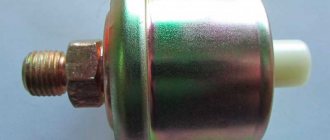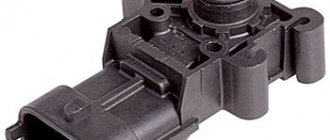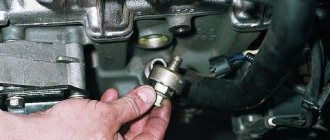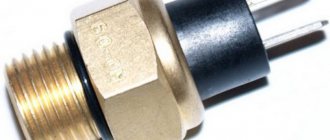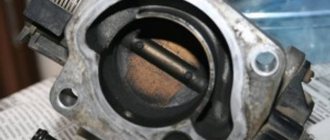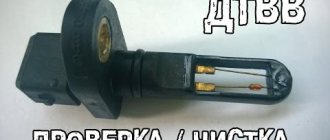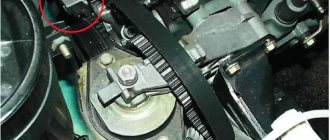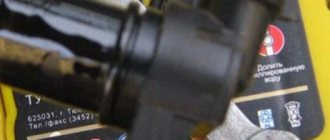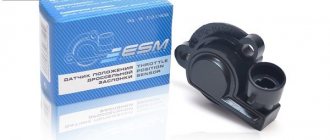The VAZ 2107 oil pressure sensor transmits information about the lubricant level to the warning lamp, and in the event of engine problems and sudden changes in fluid pressure, the corresponding diagnostic indicator lights up on the dashboard. An active warning lamp may indicate not only a malfunction of the oil supply system, but also a breakdown of the sensor itself. The spare part looks like this:
In a retail auto store, such a part costs no more than 150 rubles. Purchase only licensed spare parts that are capable of reaching their full service life.
Why does the oil pressure sensor on the "seven" break down?
Reasons why the oil pressure sensor (hereinafter referred to as OPM) may become unusable:
- oxidation of contacts and other metal parts;
- depressurization of the sensor;
- contamination of the DDM inlet port;
- loose threaded connection.
Also, the part is damaged due to violation of the temperature conditions of the car operation or mechanical damage.
How to check the oil pressure sensor of a VAZ 2107
- Remove the sensor;
- Install an analog or digital pressure gauge in the input port instead of a sensor;
- If the device data does not exceed 0.35-0.4 kg/cm², then the oil pressure has dropped and replacement of the part is not necessary. Working pressure on Zhiguli cars is ≤1 kg/cm².
DDM for old VAZs was produced of one type: a part from any eight-valve Lada will do. The functionality of the unit can be checked without a pressure gauge. To do this, you need to unscrew the sensor and crank the starter for a few seconds, without starting the engine. If oil splashes fly from the hole under the sensor, then the pressure in the system is normal.
Reasons for the indicator to light up
It should be noted that the oil pressure light may come on intermittently in some situations without presenting any danger to engine operation. Such situations include:
- If the car makes a sharp turn, as a result, not only the oil indicator, but also the fuel indicator may light up for a few seconds.
- When starting the engine in winter.
- After prolonged parking on uneven surfaces, when the lubricant flows into other engine compartments.
If the light comes on while driving or at idle, and does not go out after a while, then appropriate measures should be taken. The oil pressure indicator indicates the occurrence of failures and malfunctions. Such problems occur not only in the engine, but also in the electronic part. Some of the main reasons why this indicator lights up include:
- Reduced oil level in the system. This is precisely the fact that, when it occurs, the indicator must necessarily work, warning of the danger of further operation of the VAZ-2107 car.
- If the oil filter is worn excessively.
- There is a malfunction of the sensor itself or a short circuit in the wiring.
- Excessive wear of the crankshaft bearings.
- Oil pump malfunction.
Level needs to be checked
In certain cases, it is necessary to stop and determine the presence of oil in the engine using a dipstick. If the level is normal, then you should get to the nearest station or home, and then determine the reason for the light coming on. If there is no oil, then continuing to move under your own power is strictly prohibited, because this may cause the motor to jam.
If the pressure indicator lights up, you should make an emergency stop and turn off the engine. After this, a number of steps should be taken to determine the cause of such consequences.
Checking the lubricant level
After stopping, you need to open the hood and remove the dipstick. The measuring scale of the dipstick should be wiped, then reinsert it into the hole, and then remove it and make sure there is a sufficient level of lubricant. If the dipstick shows a minimum fluid level, then you should top it up, but then try to find out the reasons for the decrease in level. Often the reason for a drop in oil level is its leakage through the seals, which need to be changed periodically.
After the oil is added to the engine, the indicator will not light up, which indicates that the cause has been correctly eliminated. Low oil pressure in the engine can also be determined using a special dial-type indicator, which displays information for the driver about the state of oil pressure. However, on VAZ 2107 cars such indicators are not installed from the factory, although some motorists install them themselves.
Oil filter malfunction
If the lubricant level is in order, then the cause of such consequences may be a faulty filter. If you recently changed the oil and filter, and after some time the light comes on, then there is a high probability that you have received a defective filter. Under such circumstances, you will need to replace not only the filter, but also the lubricant in the system. Such cases, although rare, are all appropriate.
Checking the health of the sensor
The malfunction may consist of a breakdown of the sensor itself or a short circuit in the supply wiring. To check the health of the sensor, there are two ways:
- Measure the pressure by screwing an adapter with a pressure gauge into the sensor seat.
- Measure the resistance using a multimeter and a pump with a pressure gauge.
In the first case, the pressure in the system must be at least 0.35 kgf/cm2. The value on the pressure gauge is not lower than the specified one, indicating that the system is working properly and the sensor is faulty. In the second case, the test involves connecting the multimeter probes to the sensor terminals. In this case, the device should show zero resistance. Now you need to pump using the pump, as a result of which the multimeter readings should change and it will show infinity. In order to check the integrity of the wiring suitable for the sensor, you should test it using a multimeter. Replacing the sensor is not particularly difficult, so even a beginner can cope with this task.
Checking the quality of the lubricant
If all of the above methods have been tried, but the icon continues to light, then you should check the quality of the oil. To do this, you need to inspect the dipstick, with which you can easily determine the presence of signs of antifreeze or gasoline in the lubricant. To do this, you need to dip the dipstick in water and see if streaks appear on the surface, then the reason is that foreign liquid has entered the motor.
In such a situation, a complete flush of the engine, as well as major repairs, cannot be avoided. It is necessary to eliminate the cause of gasoline or antifreeze getting into the engine compartment.
From the above, it should be noted that in order to avoid unpleasant situations, when the oil pressure light comes on, you should immediately stop and find the cause.
Replacing the oil pressure sensor with a pressure gauge
For the “classics,” a popular type of handicraft modification is when, instead of the DDM, an analog or digital pressure gauge is installed for ease of reading: the built-in device will allow you to determine the current oil pressure, ignoring the signals from the warning lamps.
For installation, an analog type pressure gauge is recommended, where the lower scale value is zero and the maximum is six. There is no need to use devices with sky-high scale steps, since the operating oil pressure in the “classic” is about 1 kg/cm².
For installation you will need:
- Pressure measuring device;
- A dense hose, identical in diameter to the hole for installing the DDM.
At the end of the hose there should be metal threaded connections of the “fitting” type as in the illustration below.
One end of the hose is attached to the pressure gauge, the other to the sensor port. The hose must be pulled into the cabin, securing the pressure meter in a convenient place. You also need to bleed the air from the hose, otherwise the device will display false readings. The modification is suitable for those who do not have a warning light on the dashboard.
The operation of an internal combustion engine depends not least on the correct oil pressure. If the oil pressure is insufficient, then the wear of rubbing parts increases sharply, which leads to rapid engine breakdown and expensive repairs. On some carburetor cars with mechanical and electronic ignition, the oil level sensor was connected to a dial indicator, so the driver could independently assess the condition of the engine and the operation of the oil system. This type of sensor was called control.
On more advanced carburetor cars, an emergency oil pressure sensor was installed, which notified the driver of a critical deterioration in the operation of the lubrication system. The same devices were also used on outdated diesel engines with mechanical injection. With the transition to an emergency oil pressure sensor, which reacts only when the pressure drops below a certain level, installing a conventional sensor that reports data to a dial indicator has lost its meaning, however, it was installed on some fuel-injected cars until the middle of the first decade of the 21st century.
On modern injection and diesel cars, the oil pressure sensor is connected to one of the controller inputs, so the data from it is not displayed in any way on the front panel. When oil pressure drops to dangerous levels, the Check Engine light comes on. If the oil pressure drops even lower, the controller will shut off the fuel supply, avoiding serious engine damage.
Trends in modern engine building
If in the recent past, most modern car engines were naturally aspirated and had a volume of 3 liters or more, making it possible to extract about 90 horsepower from one liter of working volume, today you can only see such huge units on American models. Most European and Japanese brands use small-displacement turbocharged power units in their cars, which are lightweight, have excellent dynamic characteristics, have increased power, good fuel economy, and fully comply with current environmental standards.
The need to use such turbocharged engines is dictated by strict environmental requirements. Automakers are trying to offer their customers a powerful engine that is both economical and easy to operate.
The latter is important in the context of constantly rising prices for automobile fuel. The compact, lightweight engine significantly reduces the weight of the front end of the vehicle, improving weight distribution and high-speed behavior.
Also in recent years, compact city hatchbacks have become popular, in which it is simply not possible to install a huge engine in a small engine compartment.
How oil pressure sensors work
The oil pressure control sensor is a pressure gauge connected to a wirewound potentiometer, the resistance of which directly depends on the oil pressure on a metal membrane. The emergency oil pressure sensor consists of a membrane connected to normally closed contacts. As the oil pressure increases, the membrane begins to put pressure on the contacts and at a pressure of 0.5-1 atmosphere the contacts open. The membranes of both sensors, as well as all electrical parts, are located inside a sealed, rolled housing. The circuit of the potentiometer or contacts is formed by the thread of the tip, which is screwed into the place intended for the sensor, and the signal pin. Sometimes an oil pressure sensor is used, which includes both a pressure gauge with a potentiometer and open contacts. Such sensors are usually called universal.
Advice from experienced
It cannot be said that one electronic emergency oil pressure sensor is convenient. The light does not go out, but it is not visible what pressure is in the lubrication system at this moment.
Also, if the oil was not changed on time, different brands were used, and after a major engine overhaul, clots may form in the system, due to which the sensor may not work on time. Oil starvation will occur, which will lead to a decrease in engine life or its wedge.
To solve this problem, experienced motorists recommend installing, in addition to the electronic sensor, a mechanical one with readings displayed on the dashboard through a pressure gauge.
To do this, automobile Kulibins use a special tee (2103-3810610), a fitting (2103-3810310), and two gaskets (10282460), with the help of which a mechanical analogue sensor and a standard electronic one are connected to the lubrication system.
A pressure gauge is mounted on the dashboard in any convenient place. You can take it from any VAZ “classic”, Moskvich or UAZ. The main thing is that the scale is convenient and understandable for you.
The wires from the DDM are placed in a hose or plastic corrugation and carefully mounted in the engine compartment. This must be done in such a way that they do not overheat and are not subject to mechanical stress.
Where is the oil pressure sensor located on VAZ cars?
On all cars of the “classic” VAZ series (2101-2107), the sensor is located in the left rear part of the cylinder block, next to the gearbox and steering column. On all 8-valve engines of front-wheel drive VAZ cars, including modern Kalina, Granta and Priora, the sensor is located on the rear left side of the cylinder head (cylinder head), next to the timing belt casing and the injector receiver. On all 16-valve engines, the oil pressure sensor is located on the left end of the cylinder head, where the left timing shaft bearing is located.
Modifications of the VAZ-2107 car
VAZ-2107. Basic version of the sedan, with an 8-valve carburetor VAZ-2103 engine, 1.5 liters.
VAZ-2107-20. The same VAZ-2107, but with a 1.5-liter VAZ-2104 injection engine that meets the Euro-2 environmental standard.
VAZ-2107-71. The car for the Chinese market was equipped with a VAZ-21034 engine, with a volume of 1.4 liters and a power of 66 horsepower, specially tuned for A-76 gasoline. The pistons were taken from a VAZ-2108.
VAZ-21070. Modification of a car with an 8-valve, carburetor VAZ-2103 engine, volume 1.5 liters.
VAZ-21072. Modification with an 8-valve carburetor VAZ-2105 engine, volume 1.3 liters.
VAZ-21073. An export modification for the European market, which was equipped with a 1.7-liter injection engine with a capacity of 84 horsepower. The engine of this car had a catalytic converter that satisfied environmental protection requirements.
VAZ-21074. Modification with an 8-valve, carburetor VAZ-2106 engine, volume 1.6 liters.
VAZ-21074-20. Modification with a 1.6-liter VAZ-21067-10 injection engine, which complies with the Euro-2 environmental standard
VAZ-21074-30. Like the previous model, but with a VAZ-21067-20 engine, which meets the Euro-3 environmental standard
VAZ-210740. Modification produced in 2010, equipped with a VAZ-21067 injection engine with a catalyst. Engine capacity is 1.6 liters, power is 72.7 horsepower.
VAZ-21076. Export modification with a VAZ-2103 carburetor engine.
VAZ-21077. Export modification with right-hand drive for the UK market. The car was equipped with a VAZ-2105 carburetor engine with a volume of 1.3 liters.
VAZ-21078. Another export modification for the UK, but with a 1.6-liter VAZ-2106 carburetor engine
VAZ-121079. The modification, developed specifically for the needs of the Ministry of Internal Affairs and the KGB, was equipped with a powerful VAZ-413 rotary piston engine with a volume of 1.3 liters and a power of 140 horsepower.
VAZ-2107 ZNG. The car is equipped with an 8-valve, fuel-injected VAZ-21213 engine with a volume of 1.7 liters.
Source
Malfunctions and checking the oil pressure sensor
Here are the most common malfunctions of oil pressure sensors that occur on any car:
- loss of tightness of the sensor, as a result of which oil gets inside and changes the operation of the electrical part;
- contamination of the sensor inlet;
- leakage of the threaded connection of the sensor and cylinder head;
- oxidation of sensor contacts;
- incorrect sensor readings.
There are two ways to check the sensor: screw a pressure gauge adapter into the sensor seat, or connect the sensor to a pneumatic pump through a suitable adapter. In the first case, it will be possible to check not only the sensor, but also the operation of the oil system; in the second, only the serviceability of the sensor and the reliability of its readings.
Replacing the oil pressure sensor
To replace the sensor, you only need a 19-size open-end wrench for classic VAZ cars and a 21-size for front-wheel drive cars. On foreign cars, the location of the sensor and the size of the key may differ, so carefully read the repair and operating instructions for your car. Carry out the replacement with a cold, switched off engine.
The replacement itself is not difficult even for an inexperienced driver. The step-by-step replacement procedure is described below.
- Remove the wire terminal from the sensor terminal and move the wire to the side so that it does not interfere.
- Use a wrench to unscrew the sensor.
- Get him out.
- Inspect the area around the sensor for oil leaks. If found, replace the aluminum or copper O-ring.
- Place the old or new O-ring on the new sensor and screw it into the seat (if you bought a sensor with an O-ring on it, do not use the old one, even if it did not leak). Do not overdo it, the maximum effort should not exceed 1-1.5 kilograms.
- Connect the wire terminal to the sensor terminal.
- If, after turning on and warming up the engine, the oil sensor begins to leak, install a new O-ring and check its threads. You may have screwed it in the wrong way.
How to choose a new oil pressure sensor
When selecting a sensor, consider the following: A sensor from the vehicle/engine manufacturer or its partners is always better than one from a third party. This is especially true for Russian cars. Make sure the sensor you choose is suitable for your vehicle. If you and the seller do not know which sensor you need, then refer to your car's engine repair manual or parts and spare parts catalog. The catalog number of the sensor is indicated there. Before purchasing a sensor, ask the seller to present documents for it. If the seller cannot provide any accompanying documents, it means that the sensor was manufactured by someone unknown, so no one knows whether it will fit your engine according to its internal settings or not.

